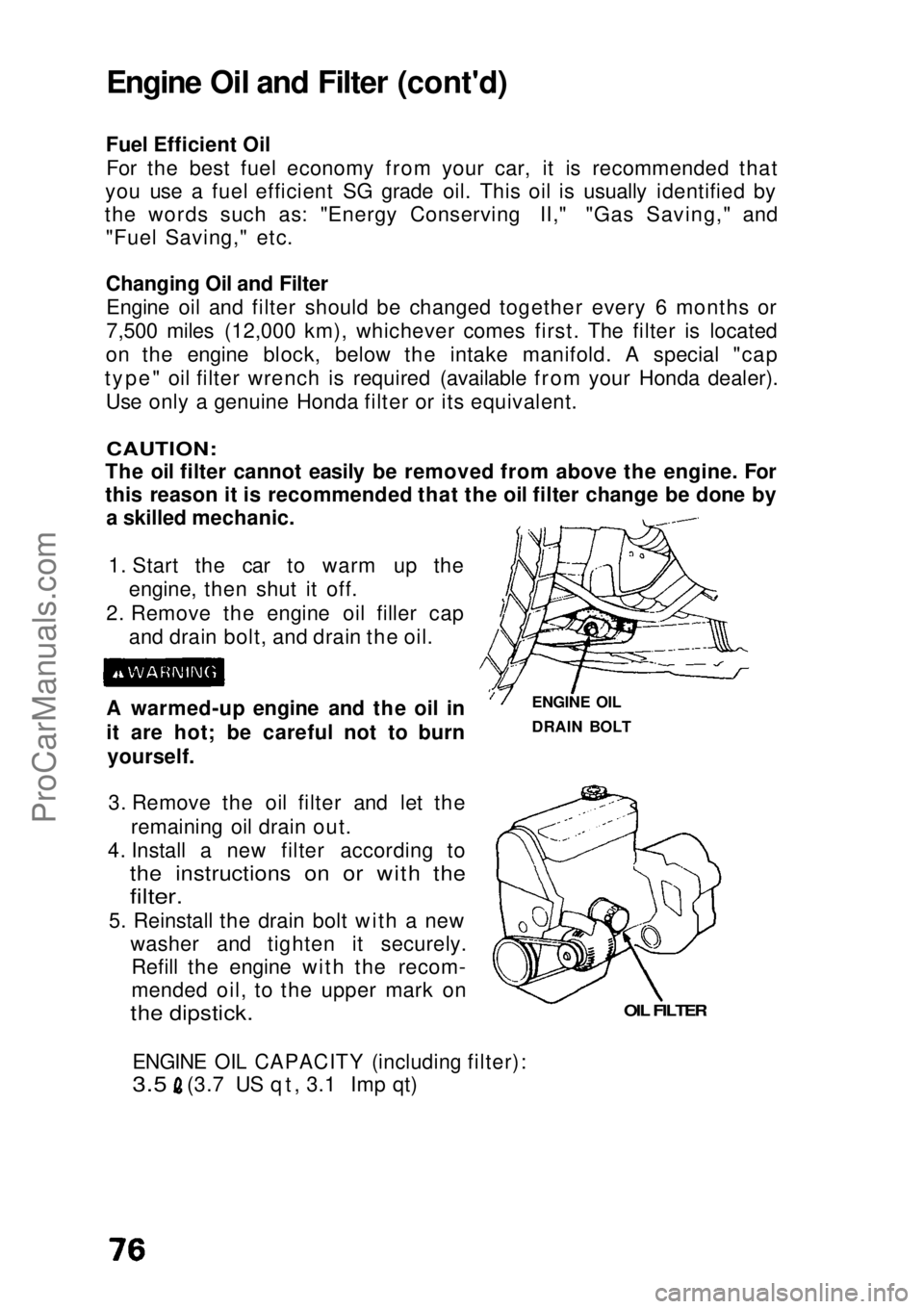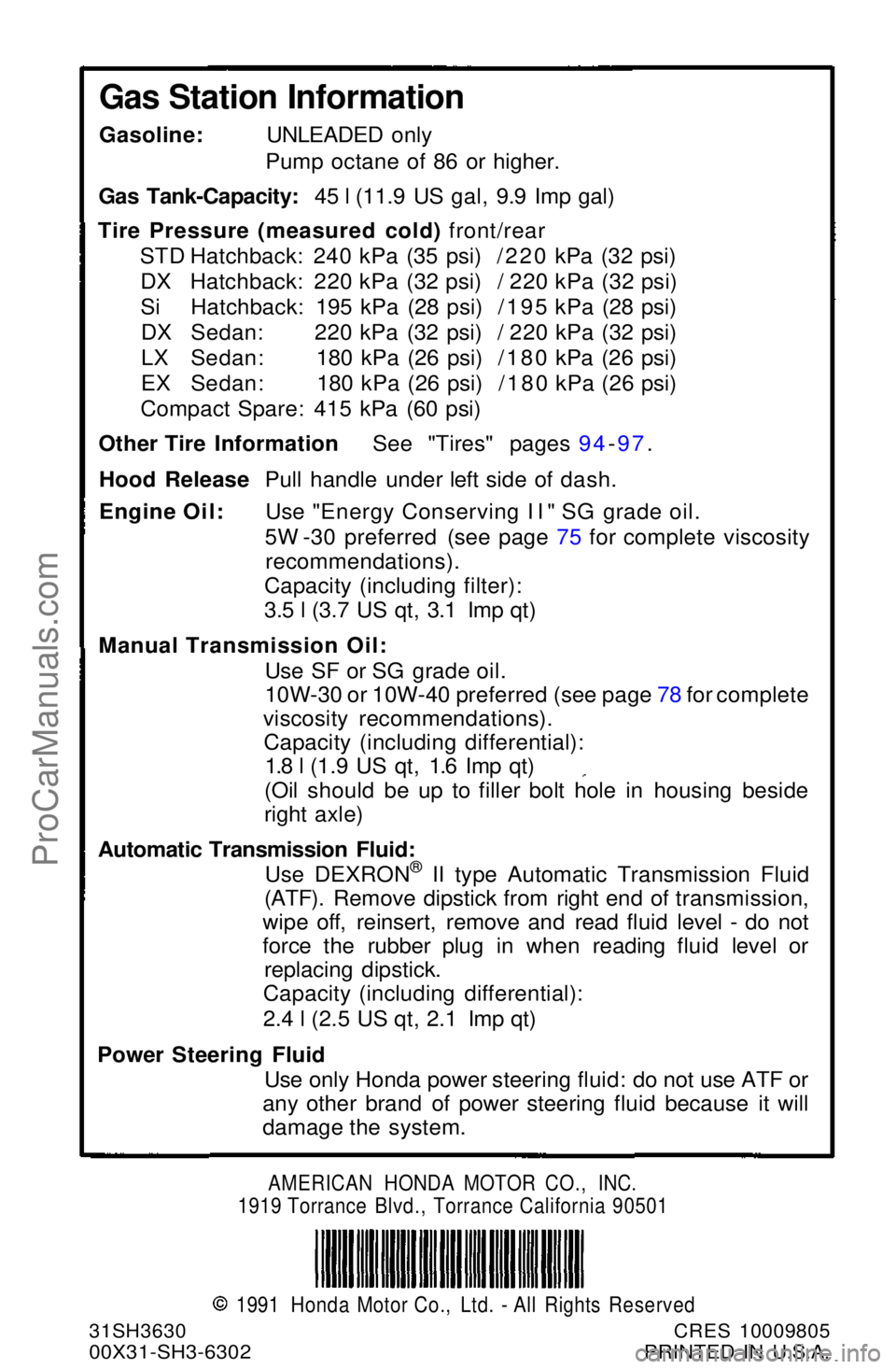1991 HONDA CIVIC gas type
[x] Cancel search: gas typePage 55 of 136

For proper operation of your car's emission controls, your engine is
designed to use unleaded fuel only.
CAUTION:
Using leaded or even low-lead gasoline could damage some of your
emission controls, and also void their coverage under the emission
controls warranty.
Use gasoline from pumps labeled unleaded, with a pump octane
number of 86 or higher. The pump octane number is an average of
the Research (R) octane and Motor (M) octane numbers. Use of a lower octane gasoline can cause persistent, heavy "spark knock" (ametallic rapping noise), which can lead to engine damage if severe.
CAUTION:
If you notice steady spark knock while holding a steady speed on a
level road, try changing brands of gasoline. If the spark knock persists, consult your Honda dealer. Failure to do so is considered
misuse, and misuse is not covered under the New Car Warranty.
Occasionally you may notice light spark knock while accelerating or
driving up hills. This is no cause for concern, it simply means your
engine is running at its most economical.
Gasoline Containing AlcoholIf you decide to use a gasoline containing alcohol ("gasohol"), be
sure its octane rating is at least as high as that recommended for
unleaded gasoline. There are two types of "gasohol": that
containing ethanol, and that containing methanol. Do not use
gasohol that contains more than 10% ethanol. Do not use gasoline
containing methanol (methyl or wood alcohol) that does not also contain cosolvents and corrosion inhibitors for methanol. Never use
gasoline containing more than 5% methanol, even if it has cosolvents and corrosion inhibitors.
NOTE.
Fuel system damage or vehicle performance problems resulting
from the use of such fuels is not covered under the new car warranties. Honda cannot endorse the use of fuels containing methanol since evidence of their suitability is as yet incomplete. Before purchasing fuel from an unfamiliar station, try to confirm
whether the fuel contains alcohol, of what kind, and how much. If
you notice any undesirable operating symptoms after using a
gasoline that contains alcohol; or one that you think contains alcohol, switch to an unleaded gasoline, as recommended above.
GasolineProCarManuals.comMain Menu s t
Page 68 of 136

Your Honda automobile must be properly maintained to ensure that
it is in peak operating condition and the emission levels are within
the standards set by the Federal Clean Air Act. The following instructions and maintenance procedures are basedon the assumption that your car will be used exclusively for thepurpose for which it was designed:
1.To carry passengers and cargo within the load limits shown on the label in the glove box.
2. To be driven on reasonable road surfaces within legal limits.
3. To generally be driven daily over a distance of several miles.
4. Use gasoline from pumps labeled unleaded, with a pump octane number of 86 or higher. The pump octane number is an average of
the Research (R) octane and Motor (M) octane numbers.
NOTE: Failures which occur due to a lack of maintenance will not be
covered under warranty.
The Required Maintenance Schedule* specifies all maintenance
required to keep your car in peak operating condition. Work should
be done by a Honda dealer but may be done by any qualified service
facility or individual who is competent in this type of work.
Maintenance, replacement, or repair of emission control devices
and systems may be done by any automotive repair establishment
or individual using parts that are "certified" to EPA standards.
After the maintenance has been done, be sure to complete theMaintenance Records on pages 71 — 73. All required maintenance is
considered normal owner operating cost and you will be charged for it by your dealer.
* For vehicles sold in California, maintenance operations indicated by *3 on page 70 are recommended by the manufacturer. Othermaintenance operations are required by California regulations and
condition the emission warranty.
Maintenance Schedule and RecordsProCarManuals.comMain Menu s t
Page 76 of 136

Engine Oil and Filter (cont'd)
Fuel Efficient Oil For the best fuel economy from your car, it is recommended that
you use a fuel efficient SG grade oil. This oil is usually identified by
the words such as: "Energy Conserving II," "Gas Saving," and "Fuel Saving," etc.
Changing Oil and Filter
Engine oil and filter should be changed together every 6 months or
7,500 miles (12,000 km), whichever comes first. The filter is located
on the engine block, below the intake manifold. A special "cap
type" oil filter wrench is required (available from your Honda dealer). Use only a genuine Honda filter or its equivalent.
CAUTION:
The oil filter cannot easily be removed from above the engine. For
this reason it is recommended that the oil filter change be done by a skilled mechanic.
1. Start the car to warm up the engine, then shut it off.
2. Remove the engine oil filler cap and drain bolt, and drain the oil.
A warmed-up engine and the oil in
it are hot; be careful not to burn yourself.
3. Remove the oil filter and let the remaining oil drain out.
4. Install a new filter according to
the instructions on or with the
filter.
5. Reinstall the drain bolt with a new washer and tighten it securely.Refill the engine with the recom-
mended oil, to the upper mark on
the dipstick.
ENGINE OIL CAPACITY (including filter):
3.5
(3.7 US qt, 3.1 Imp qt)
OIL FILTER
ENGINE OIL
DRAIN BOLTProCarManuals.comMain Menu s t
Page 136 of 136

AMERICAN HONDA MOTOR CO., INC.
1919 Torrance Blvd., Torrance California 90501 1991 Honda Motor Co., Ltd. - All Rights Reserved
31SH3630 CRES 10009805
00X31-SH3-6302 PRINTED IN U.S.A.
Gas Station Information
Gasoline: UNLEADED only
Pump octane of 86 or higher.
Gas Tank-Capacity: 45 l (11.9 US gal, 9.9 Imp gal)
Tire Pressure (measured cold) front/rear STD Hatchback: 240 kPa (35 psi) /220 kPa (32 psi)DX Hatchback: 220 kPa (32 psi) / 220 kPa (32 psi)
Si Hatchback: 195 kPa (28 psi) /195 kPa (28 psi)DX Sedan: 220 kPa (32 psi) / 220 kPa (32 psi)
LX Sedan: 180 kPa (26 psi) /180 kPa (26 psi)
EX Sedan: 180 kPa (26 psi) /180 kPa (26 psi)
Compact Spare: 415 kPa (60 psi)
Other Tire Information See "Tires" pages 94-97.
Hood Release Pull handle under left side of dash.
Engine Oil: Use "Energy Conserving II" SG grade oil. 5W -30 preferred (see page 75 for complete viscosityrecommendations).
Capacity (including filter):
3.5 l (3.7 US qt, 3.1 Imp qt)
Manual Transmission Oil: Use SF or SG grade oil.
10W-30 or 10W-40 preferred (see page 78 for complete
viscosity recommendations). Capacity (including differential): 1.8 l (1.9 US qt, 1.6 Imp qt)
(Oil should be up to filler bolt hole in housing beside
right axle)
Automatic Transmission Fluid:
Us
e
DEXRON® II type Automatic Transmission Fluid
(ATF). Remove
dipstick from right end of transmission,
wipe off, reinsert, remove and read fluid level - do not
force the rubber plug in when reading fluid level or replacing dipstick.
Capacity (including differential):
2.4 l (2.5 US qt, 2.1 Imp qt)
Power Steering Fluid Use only Honda power steering fluid: do not use ATF or
any other brand of power steering fluid because it will
damage the system.ProCarManuals.comMain Menu s t